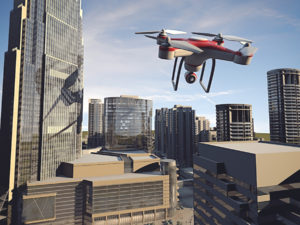Drones and cyber liability are all over the news these days. And they have big implications for architectural practice. The AIA Trust has just published guides on each of these topics to help architects navigate new regulations and risks.
An Architect’s Guide to Using Drones
 Drones—also called unmanned aerial vehicles (UAVs) or unmanned aerial systems (UAS)—are flying devices that do not carry a human pilot. There is now a proliferation of mass-produced, inexpensive unmanned aircraft with capabilities that surpass anything previously available to civilians.
Drones—also called unmanned aerial vehicles (UAVs) or unmanned aerial systems (UAS)—are flying devices that do not carry a human pilot. There is now a proliferation of mass-produced, inexpensive unmanned aircraft with capabilities that surpass anything previously available to civilians.
A new AIA Trust guide is intended to help architects understand these regulations when utilizing drones in their design practices.
The federal rules related to drone usage have been happening at a fast pace. These rules apply to people and organizations who want to fly drones for hire or want to use them in their work or in business. A new AIA Trust guide is intended to help architects understand these regulations when utilizing drones in their design practices. Legal considerations related to the use of drones in a commercial setting, along with liability considerations about the use of drones within a design professional’s services are discussed.
An Architect’s Guide to Cyber Liability Coverage
 Increasing awareness of cyber liability due to cyberattacks is fueling demand for cyber liability insurance. The unique exposures and liabilities associated with privacy breaches and cyberattacks are not properly addressed in traditional general liability and professional liability coverage.
Increasing awareness of cyber liability due to cyberattacks is fueling demand for cyber liability insurance. The unique exposures and liabilities associated with privacy breaches and cyberattacks are not properly addressed in traditional general liability and professional liability coverage.
While the number of insurance carriers writing this coverage has increased, there is no standardized policy form. Therefore, understanding the various types of risks and comparing policy forms to identify key coverage differences are important for the architect considering this coverage to make an educated decision.
Find out how to evaluate cyber liability policy options and select the best coverage to address your firm’s needs with this new guide.